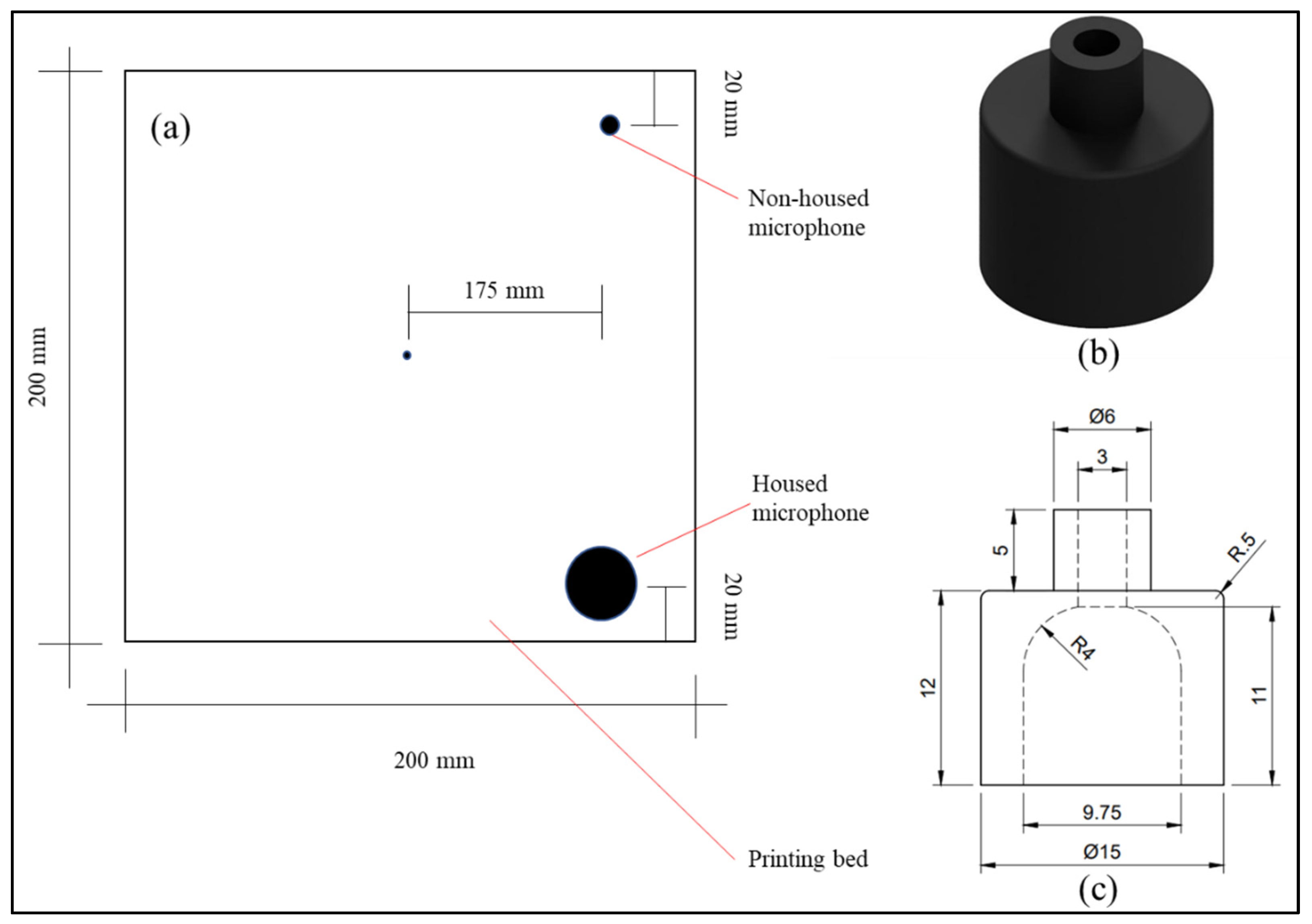Evaluating Temperature Influence on Low-Cost Microphone Response for 3D Printing Process Monitoring †
Abstract
:1. Introduction
2. Material and Methods
2.1. Experimental Setup
2.2. Signal Processing
3. Results and Discussion
3.1. Raw Signal Analysis
3.2. Frequency Spectrum Analysis
4. Conclusions
Author Contributions
Funding
Institutional Review Board Statement
Informed Consent Statement
Data Availability Statement
Conflicts of Interest
References
- Dhinakaran, V.; Manoj Kumar, K.P.; Bupathi Ram, P.M.; Ravichandran, M.; Vinayagamoorthy, M. A review on recent advancements in fused deposition modeling. Mater. Today Proc. 2020, 27, 752–756. [Google Scholar] [CrossRef]
- Srinivasan, R.; Suresh Babu, B.; Udhaya Rani, V.; Suganthi, M.; Dheenasagar, R. Comparision of tribological behaviour for parts fabricated through fused deposition modelling (FDM) process on abs and 20% carbon fibre PLA. Mater. Today Proc. 2020, 27, 1780–1786. [Google Scholar] [CrossRef]
- do Carmo, M.G.F.; Lopes, T.G.; Bombonatti, V.S.; Aguiar, P.R.; França, T.V. Study of the Defects and Geometric Anomalies on Monolayer Parts Obtained by Fused Deposition Modeling Process. Proceedings 2020, 69, 40. [Google Scholar] [CrossRef]
- Wu, H.; Yu, Z.; Wang, Y. Experimental study of the process failure diagnosis in additive manufacturing based on acoustic emission. Measurement 2019, 136, 445–453. [Google Scholar] [CrossRef]
- Bhavsar, P.; Sharma, B.; Moscoso-Kingsley, W.; Madhavan, V. Detecting first layer bond quality during FDM 3D printing using a discrete wavelet energy approach. Procedia Manuf. 2020, 48, 718–724. [Google Scholar] [CrossRef]
- Bakhoum, E.G.; Cheng, M.H.M. Novel electret microphone. IEEE Sens. J. 2011, 11, 988–994. [Google Scholar] [CrossRef]
- Nguyen, V.; Dugenske, A. An I2C based architecture for monitoring legacy manufacturing equipment. Manuf. Lett. 2018, 15, 67–70. [Google Scholar] [CrossRef]
- Iyer, N.G.; Norman, S.R. Analysis of acoustic signals from rotating machines for wear detection. In Proceedings of the 2014 International Conference on Recent Trends in Information Technology, Chennai, India, 10–12 April 2014; pp. 1–6. [Google Scholar]
- Yasuno, Y.; Itoh, T.; Yamada, A.; Nojima, Y.; Kidokoro, K.; Tajima, T.; Iguchi, Y. Temperature characteristics of single-crystal silicon electret microphones. IEEE Trans. Dielectr. Electr. Insul. 2015, 22, 3658–3662. [Google Scholar] [CrossRef]
- Lopes, T.G.; Rocha, R.M.; Aguiar, P.R.; Alexandre, F.A.; França, T.V. Evaluating Temperature Influence on Low-Cost Piezoelectric Transducer Response for 3D Printing Process Monitoring. Proceedings 2019, 42, 26. [Google Scholar] [CrossRef] [Green Version]
- Sause, M.G.R. Investigation of Pencil-Lead Breaks as Acoustic Emission Sources. J. Acoust. Emiss. 2011, 29, 184–196. [Google Scholar]
- Lopes, T.G.; Rocha, R.M.; de Aguiar, P.R.; Alexandre, F.A.; de Oliveira Conceição, P.; Viera, M.A.A.; Franca, T.V. Study of the Influence of Temperature on Low-Cost Piezoelectric Transducer Response for 3D Printing Process Monitoring. In Proceedings of the 2019 7th International Engineering, Sciences and Technology Conference (IESTEC), Panama City, Panama, 9–11 October 2019; pp. 544–549. [Google Scholar]



Publisher’s Note: MDPI stays neutral with regard to jurisdictional claims in published maps and institutional affiliations. |
© 2021 by the authors. Licensee MDPI, Basel, Switzerland. This article is an open access article distributed under the terms and conditions of the Creative Commons Attribution (CC BY) license (https://creativecommons.org/licenses/by/4.0/).
Share and Cite
Barbosa, L.; Lopes, T.G.; Aguiar, P.R.; de Oliveira Junior, R.G.; França, T.V. Evaluating Temperature Influence on Low-Cost Microphone Response for 3D Printing Process Monitoring. Eng. Proc. 2021, 10, 67. https://doi.org/10.3390/ecsa-8-11251
Barbosa L, Lopes TG, Aguiar PR, de Oliveira Junior RG, França TV. Evaluating Temperature Influence on Low-Cost Microphone Response for 3D Printing Process Monitoring. Engineering Proceedings. 2021; 10(1):67. https://doi.org/10.3390/ecsa-8-11251
Chicago/Turabian StyleBarbosa, Luanne, Thiago Glissoi Lopes, Paulo Roberto Aguiar, Reinaldo Götz de Oliveira Junior, and Thiago Valle França. 2021. "Evaluating Temperature Influence on Low-Cost Microphone Response for 3D Printing Process Monitoring" Engineering Proceedings 10, no. 1: 67. https://doi.org/10.3390/ecsa-8-11251
APA StyleBarbosa, L., Lopes, T. G., Aguiar, P. R., de Oliveira Junior, R. G., & França, T. V. (2021). Evaluating Temperature Influence on Low-Cost Microphone Response for 3D Printing Process Monitoring. Engineering Proceedings, 10(1), 67. https://doi.org/10.3390/ecsa-8-11251






